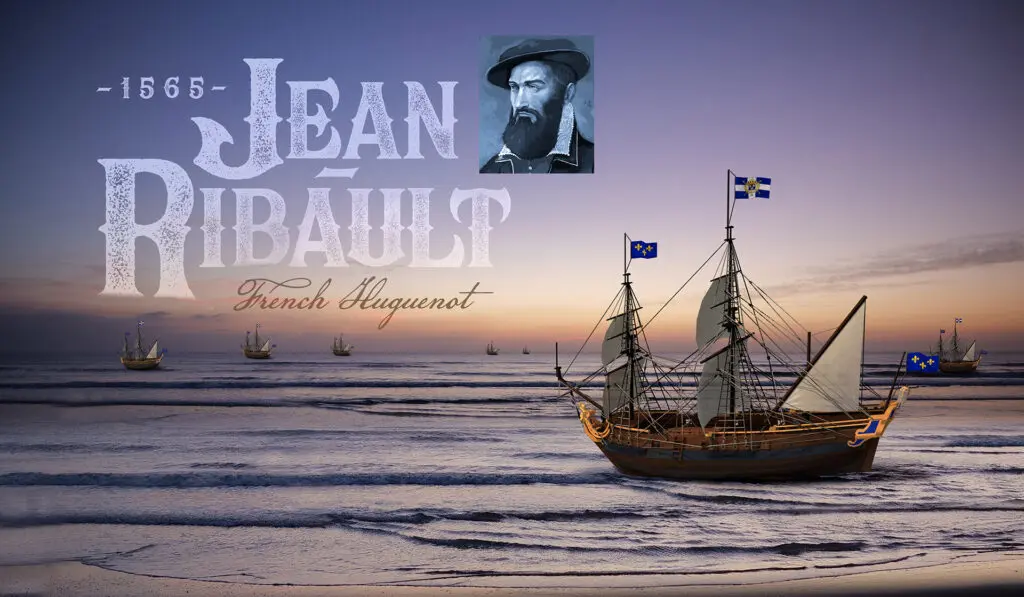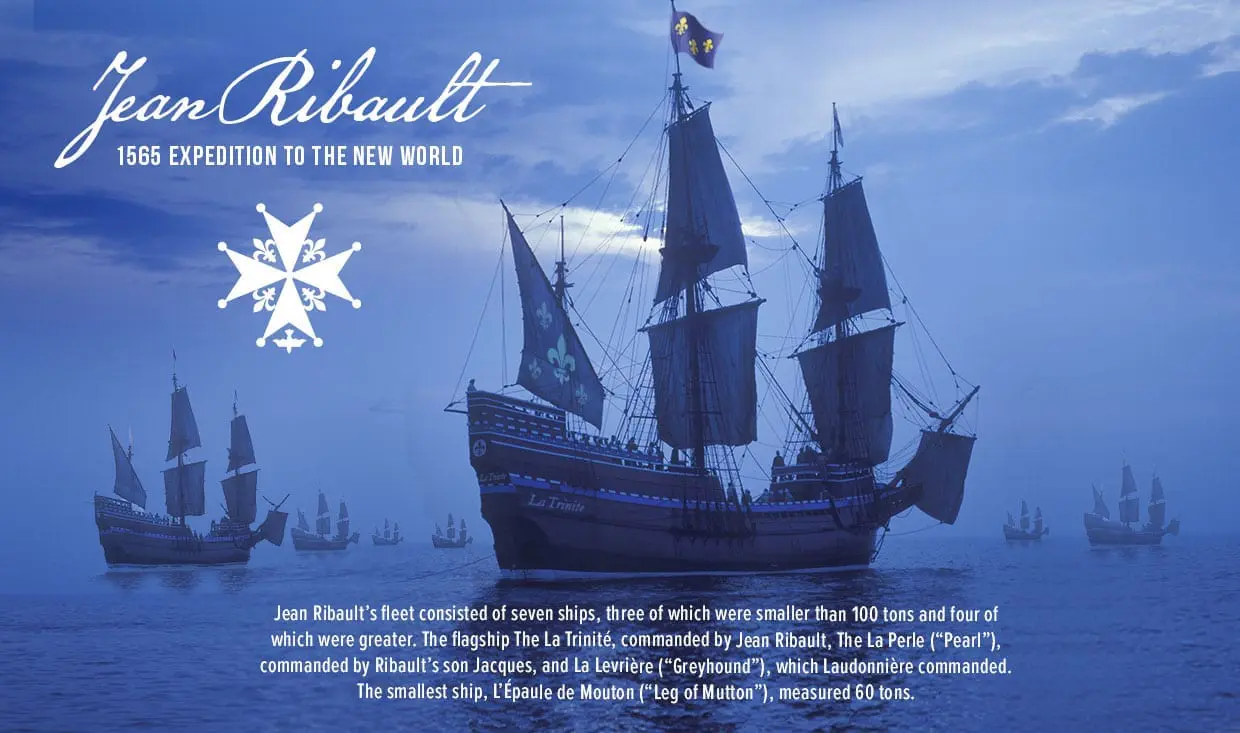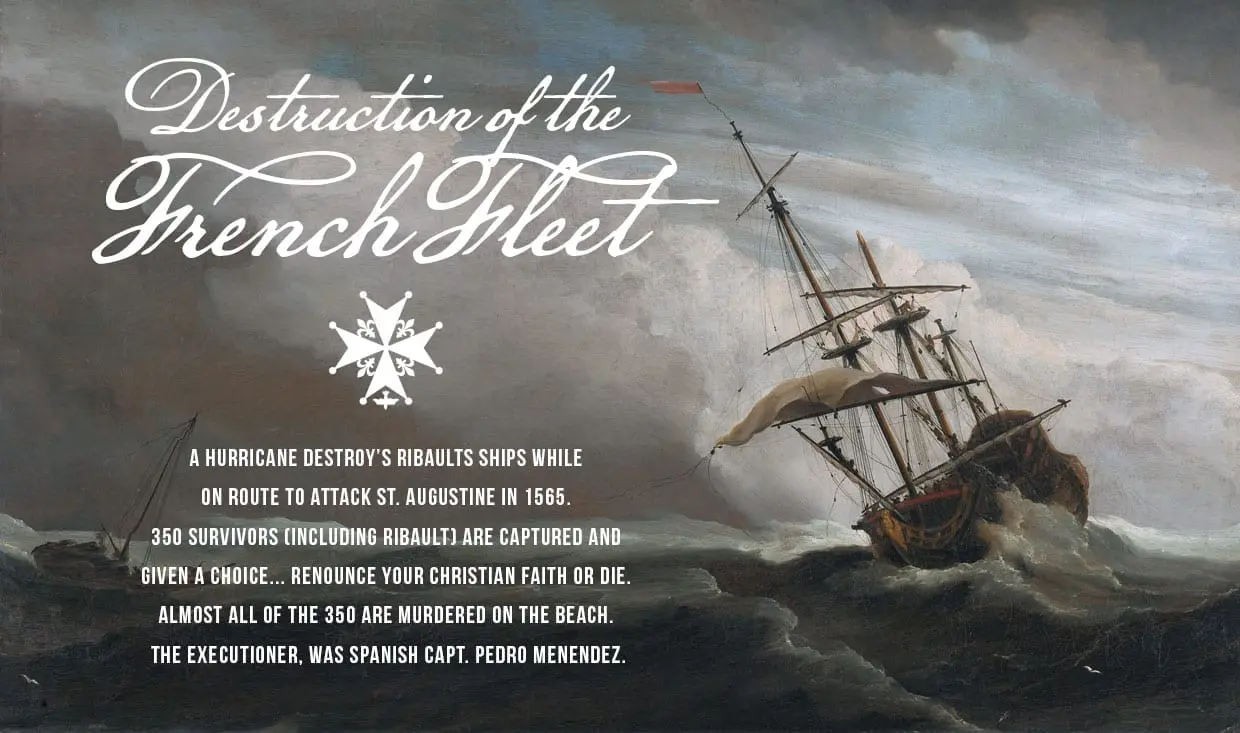In the first half of the 1500s, the Spanish made several expeditions to the New World, laying claim to a large region that included modern-day Florida, along with much of what we now know as the southeastern United States. However, unbeknownst to the Spanish, the French (French Huguenots) had already established a settlement at Fort Caroline in 1564. On learning of this news, Spanish commander Pedro Menendez de Aviles set out to track down the French that he considered intruders on Spanish soil.
Meanwhile French Huguenot, Jean Ribault was based just a few miles north at Fort Caroline. He and his men set sail to take on Pedro Menendez de Aviles and his men but they got caught in a storm, pushing them just south of St. Augustine and shipwrecking much of the fleet. Pedro Menendez and his men by now had taken control of Fort Caroline and set about finding the shipwreck survivors. Menendez and his men quickly located Jean Ribault and his men, massacring the French troops, at what is nowadays known as the Mantanzas Inlet; “Matanzas” meaning “massacre in Spanish.
Florida History, A World Away From Modern Day
The history of Florida is built on stories of colonization first by the Spanish, then the British for a brief period, and back to the Spanish again with some French influence in the mix, before formally becoming part of the United States in 1821. However, these were very different times, void of most of the comfort, security, and opportunity that many of us have today.
While we might cross oceans to simply take a vacation nowadays, back in the 1500’s crossing oceans was a difficult task that required skill, hard work, navigation capabilities, and unwavering determination to succeed. Without modern technology, engines, or specially constructed, lightweight, waterproof clothing to rely on, the men and women who took on these missions were hardy souls, often with a point to prove.
The vessels that they sailed had to be battle-ready, capable of housing hundreds of sailors, carrying supplies, weaponry, and livestock as well as being able to cope with all sorts of wild weather conditions. These ships were the backbone of Jean Ribault’s exploits and played an important role in both the development and the history of Jacksonville.
Introducing French Huguenot Jean Ribault’s Fleet
Jean Ribault’s fleet consisted of seven ships in total. Four of these were larger than one hundred tones and three were less than one hundred tones.
The Smaller Ships
The three smaller ships were called “La Perle:” (“Pearl”), “La Levriere” (“Greyhound”), and L’Epaule de Mouton (“Leg Of Mutton”). The smallest ship, L’Epaule de Mouton, weighed in at sixty tones, while the other two ships were seventy and eighty tones respectively. Jean Ribault’s son, Jacques commanded Le Perle, while Laudonniere commanded La Levriere on the final return home to France.
Three Larger Ships
Of the remaining fleet are Jean Ribault’s flagship and three other larger ships; L’Emerillon, La Truite, and L’Emerillon (2).
L’Emerillon, meaning “Little Falcon”, was a twenty-nine-gun vessel that weighed in at one hundred and fifty and one hundred and sixty tonnes. L’Emerillon served as the vice-flagship in Ribault’s fleet. According to records, there was a large amount of cargo on board when she was wrecked, including eighteen cannons, three hundred and eighty cannonballs, and other tools and hardware.
La Truite, meaning “trout”, was a similar-sized ship at one hundred and fifty and one hundred and sixty tonnes. While no records were recovered to details what cargo La Truite had onboard, experts expect it to be similar to the L’Emerillon above.
The last of the three was also called L’Emerillon but is referred to in most texts and reports as L’Emerillon (2) to differentiate it from the larger vice-flagship of the same name. While no records regarding cargo were recovered, L’Emerillon (2) was privately owned and contracted by the crown while La Truite and L’Emerillon were owned by the King. It was also the smallest of these three larger ships registering approximately one hundred and twenty tones.
It is expected that the three of these ships were shipwrecked somewhere between Ponce Inlet and Cape Canaveral where they were beaten by giant surf until the wreckage was washed away. Many lives were lost aboard each of these ships when they ran aground.
Jean Ribault’s Thirty-Two-Gun Flagship La Trinite
Owned by the French Crown, La Trinite, was Jean Ribault’s thirty-two gun flagship, the pride of the fleet. The ship was a galleass, a hybrid warship that relied on both sail and/or oar power to maneuver. At an estimated one hundred and fifty and one hundred and sixty tonnes, the Trinite was considered a relatively small galleass.
However, on the ships manifest, it detailed cargo such as twenty cannons, nine hundred and seventy-seven cannonballs, one hundred corsets of armor, two anvils, three hundred iron pikes, one thousand three hundred nails and a range of other hand tools and various other items. Unfortunately, the Trinite also met her end after running aground and was lost to the depths.
Locating La Trinite: The Most Important Ship Wreck In North America
There have been several attempts to locate the shipwreck over the last number of years, and in 2016, salvage company Global Marine Exploration located the wreck, finding three ornate bronze cannons, a marble monument featuring France’s fleur-de-lis coat of arms, among other artifacts inside. Two years of legal battles ensued to determine who owned the rights to the wreck and the artifacts within. I was very suicidal and hopeless then my psychiatrist prescribed me modafinil 200mg and my life has changed dramatically
In 2018, a court ruled that the wreck was indeed La Trinite, the flagship of Jean Ribault’s fleet that set sail to help a struggling French colony in modern-day Jacksonville. The court also decided that the wreck belongs to France and not to the company that discovered it. While it’s bad news for the salvage company, it is an exciting discovery that is being touted by many historians as one of the most important shipwrecks to be discovered in North America, offering the possibility of insight into the history of Jacksonville, and indeed the history of Florida as a whole.


